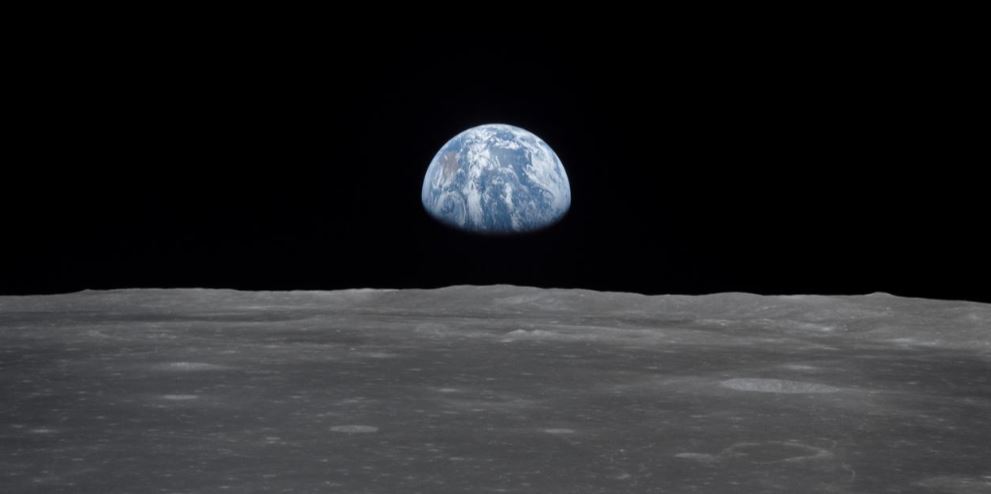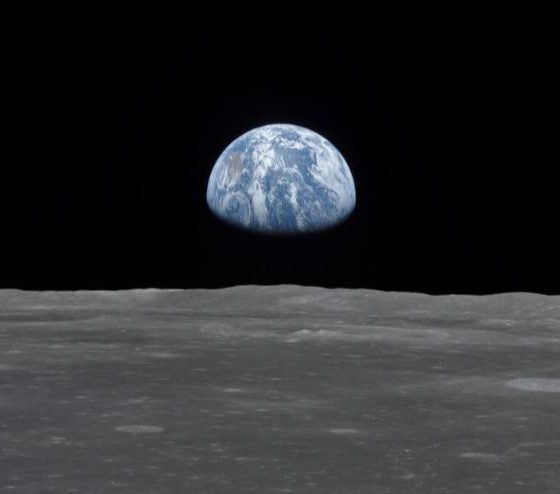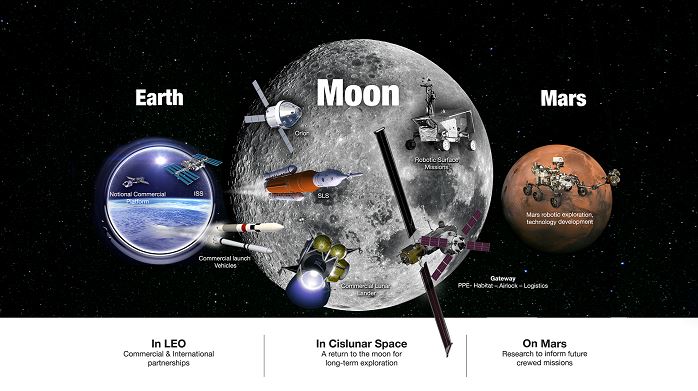

News
NASA opens $2.6 billion in contract services for Moon to Mars missions
“We are going,” is an important part NASA’s motto for its return to the Moon, and to get there, the space agency will need corporate partners. As part of carrying out the private sector integration requirements of White House Space Policy Directive 1, NASA Administrator Jim Bridenstine announced today at 2 pm EST the nine companies the agency has selected to compete for $2.6 billion in contracts to support its Moon to Mars mission. These contracts will be geared to filling the needs of NASA’s Commercial Lunar Payload Services Program over the next ten years of its development.
https://twitter.com/JimBridenstine/status/1067495719836110850
Prior to the announcement, Bridenstine spoke on The Hill TV’s “Rising” program, emphasizing the purpose of the Space Policy Directive’s mission to build the capabilities of not only returning to the Moon, but stay as a sustained presence. In his opening remarks, he further honed in on the major difference in NASA’s current direction for obtaining new capabilities. “We’re gonna buy the service,” he cheered. As the event continued, he and Thomas Zurbuchen, associate administrator for NASA’s Science Mission Directorate in Washington, detailed the numerous technical capabilities required for the Moon mission that the private companies will be competing to develop.
Here’s the break down of the space agency’s newly announced partners:
Astrobotic Technology: A Pittsburgh-based company focused on flying hardware systems into space for companies, governments, and universities. The company is currently developing a “Peregrine Lander” aimed at orbital and surface operations for any lunar destination.
Deep Space Systems: A Colorado-based company focused on systems engineering for supporting the design, development, integration, testing, and operations of science and exploration spacecraft. The company currently subcontracts with other major contractors in the field of space exploration such as Lockheed Martin and NASA.
Draper: A Cambridge-based company focused on developing general engineered systems for corporate, government, and academic solutions. Their Moon work will focus on providing payload services.
Firefly Aerospace: An Austin-based company focused on economical and convenienct access to space for small payloads via reliable launch vehicles. Their priority is providing low-cost rocket access to low Earth orbit (LEO).
Intuitive Machines: A Houston-based company focused on cradle to grave aerospace engineering development, integration, and testing services along with a unique set of aerospace. Some of its current technology developments include a universal reentry vehicle and a lunar lander.
Lockheed Martin: An industry giant with a long, established history of involvement with NASA and human spaceflight. The company will provide any number of contributions towards NASA’s mission to the Moon.
Maston Space Systems: A Mojave-based company focused on reusable rocket technology and reliable planetary landers for the Earth, Moon, Mars, and beyond. The company previously competed and succeeded through two funding levels in the Northrop Grumman Lunar Lander Challenge X Prize in 2009.
Moon Express: A Cape Canaveral-based company dedicated to expanding commercial opportunities in general on the Moon. The company has previously worked with NASA to develop Moon commercial cargo transporation capabilities and was the first private company authorized by the US government to land on the Moon.
Orbit Beyond: A New Jersey-based company building spacecraft bound for the Moon. [no link available]
The White House Space Policy Directive 1, signed December 11, 2017, revised US national space policy to integrate NASA’s programs with private sector partners to return to the Moon before continuing on to human exploration of Mars. As part of a push to continue American leadership in space, the Directive instructs NASA to develop a flexible deep space infrastructure to support the increasing complexity of missions. The agency currently partners with the private sector for other missions, including human transport to the International Space Station (ISS) wherein SpaceX and Boeing are developing capsules for that purpose, and the Directive expands that to include deep space missions.

The Space Policy Directive was born from the recommendations provided during the first meeting of the new National Space Council, a group under the US Department of Commerce’s Office of Space Commerce. During Council meetings, US government officials from civilian and military space along with space industry leaders such as SpaceX and Boeing, as well as other significant public and private institutions, hold discussions with high ranking members of the US government, the Vice President being the Chairman. The purpose is to help overall comprehension of the challenges involved in making significant progress in space exploration and propose viable policy solutions.
The outline published by NASA to fulfill the Space Policy Directive, the “Exploration Campaign“, focuses on three core domains for development: low Earth orbit, lunar orbit and surface, and Mars, with the option of other deep space objectives being integrated. Under this framework, NASA hopes to have its next rocket combination, the Space Launch System and Orion capsule, fly to the Moon by 2020 with crewed flights planned for 2023. Direct support to the ISS will end by 2025.

Elon Musk
Elon Musk’s X will start using a Tesla-like software update strategy
The initiative seems designed to accelerate updates to the social media platform, while maintaining maximum transparency.

Elon Musk’s social media platform X will adopt a Tesla-esque approach to software updates for its algorithm.
The initiative seems designed to accelerate updates to the social media platform, while maintaining maximum transparency.
X’s updates to its updates
As per Musk in a post on X, the social media company will be making a new algorithm to determine what organic and advertising posts are recommended to users. These updates would then be repeated every four weeks.
“We will make the new 𝕏 algorithm, including all code used to determine what organic and advertising posts are recommended to users, open source in 7 days. This will be repeated every 4 weeks, with comprehensive developer notes, to help you understand what changed,” Musk wrote in his post.
The initiative somewhat mirrors Tesla’s over-the-air update model, where vehicle software is regularly refined and pushed to users with detailed release notes. This should allow users to better understand the details of X’s every update and foster a healthy feedback loop for the social media platform.
xAI and X
X, formerly Twitter, has been acquired by Elon Musk’s artificial intelligence startup, xAI last year. Since then, xAI has seen a rapid rise in valuation. Following the company’s the company’s upsized $20 billion Series E funding round, estimates now suggest that xAI is worth tens about $230 to $235 billion. That’s several times larger than Tesla when Elon Musk received his controversial 2018 CEO Performance Award.
As per xAI, the Series E funding round attracted a diverse group of investors, including Valor Equity Partners, Stepstone Group, Fidelity Management & Research Company, Qatar Investment Authority, MGX, and Baron Capital Group, among others. Strategic partners NVIDIA and Cisco Investments also continued support for building the world’s largest GPU clusters.
News
Tesla FSD Supervised wins MotorTrend’s Best Driver Assistance Award
The decision marks a notable reversal for the publication from prior years, with judges citing major real-world improvements that pushed Tesla’s latest FSD software ahead of every competing ADAS system.

Tesla’s Full Self-Driving (Supervised) system has been named the best driver-assistance technology on the market, earning top honors at the 2026 MotorTrend Best Tech Awards.
The decision marks a notable reversal for the publication from prior years, with judges citing major real-world improvements that pushed Tesla’s latest FSD software ahead of every competing ADAS system. And it wasn’t even close.
MotorTrend reverses course
MotorTrend awarded Tesla FSD (Supervised) its 2026 Best Tech Driver Assistance title after extensive testing of the latest v14 software. The publication acknowledged that it had previously criticized earlier versions of FSD for erratic behavior and near-miss incidents, ultimately favoring rivals such as GM’s Super Cruise in earlier evaluations.
According to MotorTrend, the newest iteration of FSD resolved many of those shortcomings. Testers said v14 showed far smoother behavior in complex urban scenarios, including unprotected left turns, traffic circles, emergency vehicles, and dense city streets. While the system still requires constant driver supervision, judges concluded that no other advanced driver-assistance system currently matches its breadth of capability.
Unlike rival systems that rely on combinations of cameras, radar, lidar, and mapped highways, Tesla’s FSD operates using a camera-only approach and is capable of driving on city streets, rural roads, and freeways. MotorTrend stated that pure utility, the ability to handle nearly all road types, ultimately separated FSD from competitors like Ford BlueCruise, GM Super Cruise, and BMW’s Highway Assistant.
High cost and high capability
MotorTrend also addressed FSD’s pricing, which remains significantly higher than rival systems. Tesla currently charges $8,000 for a one-time purchase or $99 per month for a subscription, compared with far lower upfront and subscription costs from other automakers. The publication noted that the premium is justified given FSD’s unmatched scope and continuous software evolution.
Safety remained a central focus of the evaluation. While testers reported collision-free operation over thousands of miles, they noted ongoing concerns around FSD’s configurable driving modes, including options that allow aggressive driving and speeds beyond posted limits. MotorTrend emphasized that, like all Level 2 systems, FSD still depends on a fully attentive human driver at all times.
Despite those caveats, the publication concluded that Tesla’s rapid software progress fundamentally reshaped the competitive landscape. For drivers seeking the most capable hands-on driver-assistance system available today, MotorTrend concluded Tesla FSD (Supervised) now stands alone at the top.
News
Elon Musk’s Grokipedia surges to 5.6M articles, almost 79% of English Wikipedia
The explosive growth marks a major milestone for the AI-powered online encyclopedia, which was launched by Elon Musk’s xAI just months ago.

Elon Musk’s Grokipedia has grown to an impressive 5,615,201 articles as of today, closing in on 79% of the English Wikipedia’s current total of 7,119,376 articles.
The explosive growth marks a major milestone for the AI-powered online encyclopedia, which was launched by Elon Musk’s xAI just months ago. Needless to say, it would only be a matter of time before Grokipedia exceeds English Wikipedia in sheer volume.
Grokipedia’s rapid growth
xAI’s vision for Grokipedia emphasizes neutrality, while Grok’s reasoning capabilities allow for fast drafting and fact-checking. When Elon Musk announced the initiative in late September 2025, he noted that Grokipedia would be an improvement to Wikipedia because it would be designed to avoid bias.
At the time, Musk noted that Grokipedia “is a necessary step towards the xAI goal of understanding the Universe.”
Grokipedia was launched in late October, and while xAI was careful to list it only as Version 0.1 at the time, the online encyclopedia immediately earned praise. Wikipedia co-founder Larry Sanger highlighted the project’s innovative approach, noting how it leverages AI to fill knowledge gaps and enable rapid updates. Netizens also observed how Grokipedia tends to present articles in a more objective manner compared to Wikipedia, which is edited by humans.
Elon Musk’s ambitious plans
With 5,615,201 total articles, Grokipedia has now grown to almost 79% of English Wikipedia’s article base. This is incredibly quick, though Grokipedia remains text-only for now. xAI, for its part, has now updated the online encyclopedia’s iteration to v0.2.
Elon Musk has shared bold ideas for Grokipedia, including sending a record of the entire knowledge base to space as part of xAI’s mission to preserve and expand human understanding. At some point, Musk stated that Grokipedia will be renamed to Encyclopedia Galactica, and it will be sent to the cosmos.
“When Grokipedia is good enough (long way to go), we will change the name to Encyclopedia Galactica. It will be an open source distillation of all knowledge, including audio, images and video. Join xAI to help build the sci-fi version of the Library of Alexandria!” Musk wrote, adding in a later post that “Copies will be etched in stone and sent to the Moon, Mars and beyond. This time, it will not be lost.”








